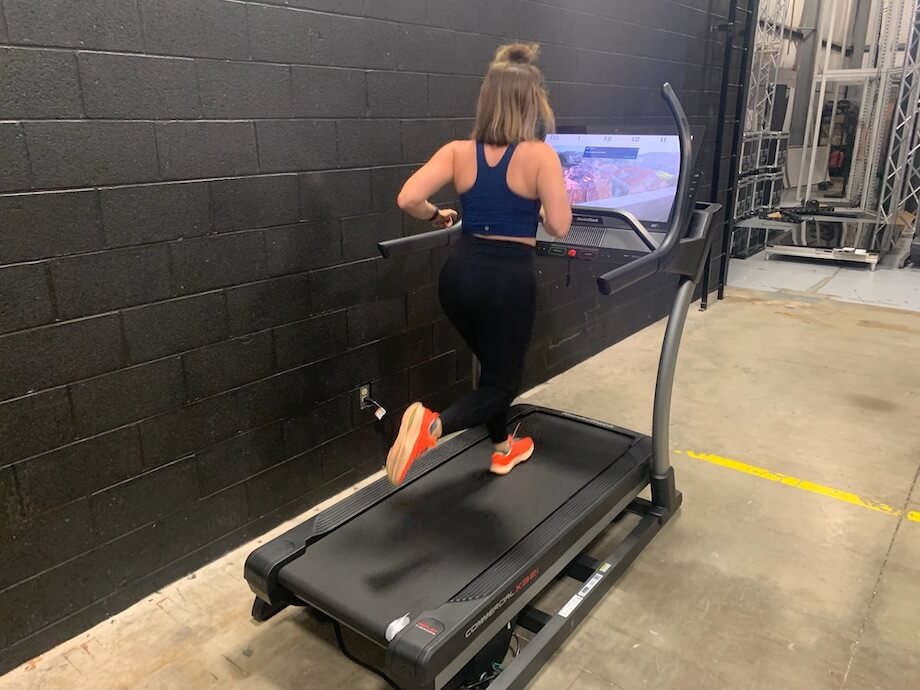We test and review fitness products based on an independent, multi-point methodology. If you use our links to purchase something, we may earn a commission. Read our disclosures.
If you’re a long-distance runner, the idea of a sprint workout may not be what you think you need in order to achieve your runner’s high. But before you stop reading, hear me out. Sprints aren’t just for those limited on time or those who prefer short bursts of intense exercise over running for longer durations.
As a longtime certified personal trainer (CPT), I believe that sprints can benefit all runners, regardless of why you’re running in the first place. Additionally, studies have shown that regular low-volume sprint interval training may help improve VO2 max and aerobic exercise performance1. What does this mean for you? Whether you’re a short, medium, or long-distance runner, incorporating sprints may help you to run faster, improve your running form, and even help with weight loss if that’s your goal.
RELATED: Best Long-Distance Running Shoes
Today, I’ll explain the benefits of sprint workouts before giving you some ideas on how to warm up properly. Then, I’ll go into my seven favorite sprint workouts for all types of runners.
Sprint Workout Benefits
There are numerous pros to sprint workouts. I consulted with certified personal trainer (CPT), weightlifting and CrossFit coach, and GGR Head of Content, Kate Meier, to get her thoughts because she’s an avid runner and has raced full and half marathons. Here are the top three benefits:
Increases Speed
There are times when speed matters. You might be running a short race or nearing the finishing line of your long-distance run. Heck, you might even be sprinting because you don’t want to miss the bus! Because you’ve taught your body to run at faster paces and activated your fast-twitch muscle fibers2, getting to your top speed is easier to do.
Improves VO2 Max
During exercise, VO2 max is the maximum oxygen consumption a person can achieve. There are multiple benefits of a high VO2 max score, including a stronger heart and lungs, more stamina and endurance, and better mental health. Yes, you read that right. During a 2022 study, a reduction in depressive symptoms was associated with improved VO2 max during high intensity interval training (HIIT)3.
Promotes Fat Burning
Sprinting can be a “time-efficient strategy for decreasing body fat while increasing aerobic capacity, peak running speed, and fat-free mass4.” Not only do you burn calories during the session, but you continue to burn them for hours afterward. This doesn’t mean you shouldn’t go for longer runs if you enjoy them; it just means you don’t always need to exert yourself for several hours. Sometimes, life takes over, but you can still get those fat-burning benefits in a 20- to 30-minute sprint session.
RELATED: Sweat And Burn Fat With These 30-Minute Treadmill Workouts
How to Warm Up for Your Sprint Workout
So, you’re ready to hit the road. Not so fast! Before you do any of our sprint workouts below, make sure you warm up properly.
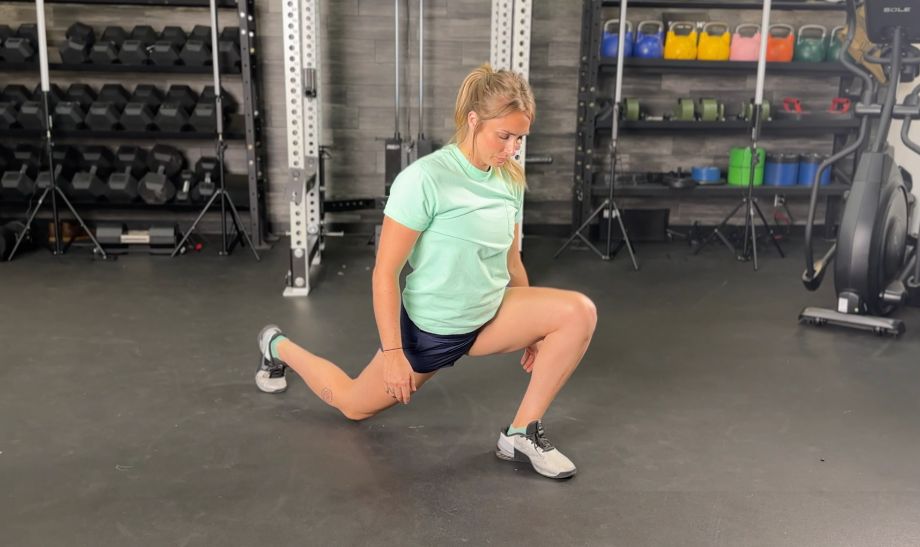
The good news? Warming up doesn’t have to add a ton of time to your run. A 2017 study in the Journal of Strength Conditioning Research5 found that a “short warm-up is as effective as a long warm-up for intermediate performance.”
Kate adds, “I’d suggest starting off by spending a few minutes simply walking outside or on a treadmill.” This will increase your body temperature and give more oxygen to your muscles. Then, do some dynamic stretches, especially those focused on the lower body. Squats, high knees, lunges, hamstring scoops, and leg swings are good examples. Aim for 10 to 20 reps of each.
RELATED: Best Warm-Up Exercises
In 10 minutes or less, you’ll be warm and ready to go. Some people may need longer than this, especially if they have injuries or experience joint pain. Otherwise, you can now start your engine with one of our sprint workouts.
Best Beginner Sprint Workout
Our beginner sprint workout is simple:
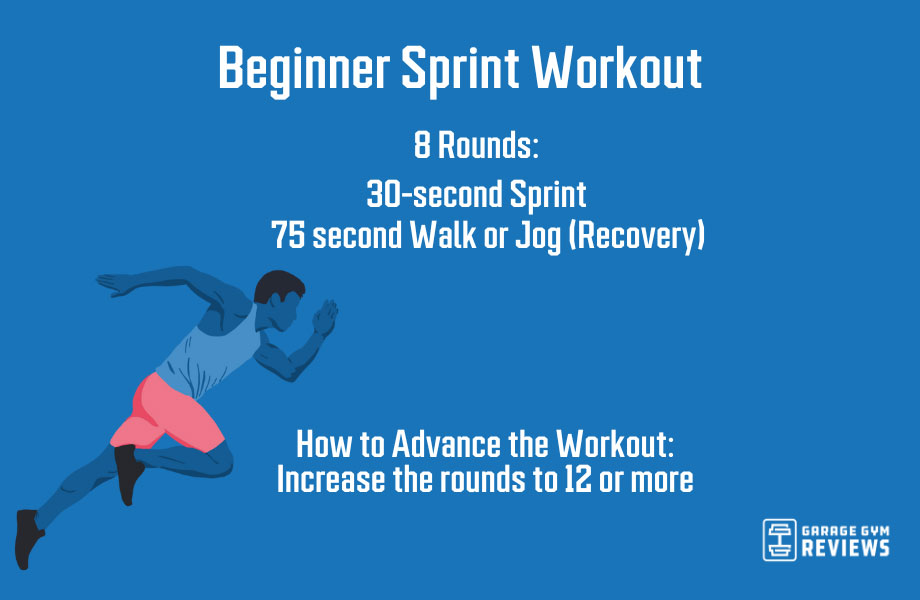
Go all-out in the sprint section, then bring your heart rate back down during your recovery period. Kate says, “Try to keep the same sprint speed throughout every interval, even if it means switching to a brisk walk during the recovery period until this becomes too easy.”
To advance, it depends on where you’re at now. If you’re unable to maintain a jogging pace during the 75 seconds, the first goal would be to get to that stage. Once this becomes easy, increase the number of rounds until you reach 12 or more. After this, move on to one of our other sprint workouts below (it’s called a beginner workout for a reason!).
Best Sprint Workout for Busy People
I get it. You’re busy and want to have the most effective training session possible. Here’s our best sprint workout for busy people:
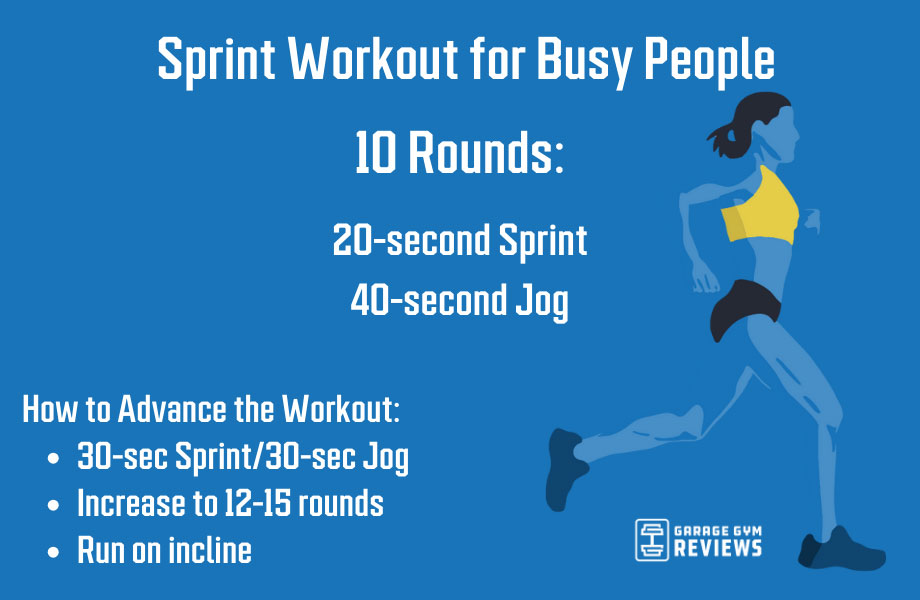
In just 10 minutes, this high-intensity sprint training will leave you sweating bucketloads. Although you have a shorter sprint than the beginner workout above, the rest time is nearly half too.
If this workout is too easy, there are a few things you can do to adjust the difficulty. Change the structure so that you’re doing a 30-second sprint instead of 20, with a 30-second recovery jog instead of 40. You can also increase the total number of rounds to 12 or 15. Or, take it up another notch and introduce some inclines to your speed training, especially if you’re using a treadmill to do your workout.
Indoor Sprint Workout
Too cold to sprint outdoors? Alternatively, too hot? I feel you. Although I love exercising outdoors, it’s definitely weather dependent for me. If you’d prefer to run inside, then check out our indoor sprint workout.
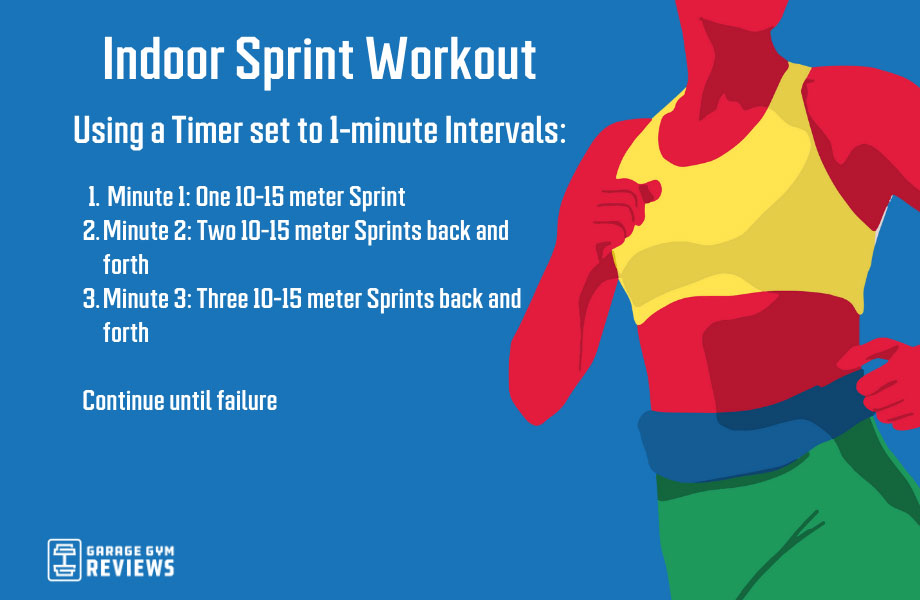
Assuming you don’t have a home treadmill, you’ll need a 10 to 15-meter space to do it. Measure out the distance and place a marker at either end. This is where you’ll be sprinting. Now, use your phone to set a timer that goes off every minute.
In minute one, do one 10 to 15-meter sprint from one marker to the other. Then, use the rest of the minute as recovery time. When the timer beeps, in minute two, do two sprints, back and forth. Rest again. In minute three of this HIIT workout, you’ll do three sprints.
You get the picture. Keep going until you can’t do it anymore. The first few minutes will seem straightforward, and you’ll be laughing at me as to how easy it is. Well, just wait and see! This indoor sprint workout tests your cardiovascular fitness, and I like it because there’s no limit. You can compete with yourself and how far you got during the last session as you try to better your performance.
Hill Sprint Workout
Ready to step it up with your training program? Below is our hill sprint workout:
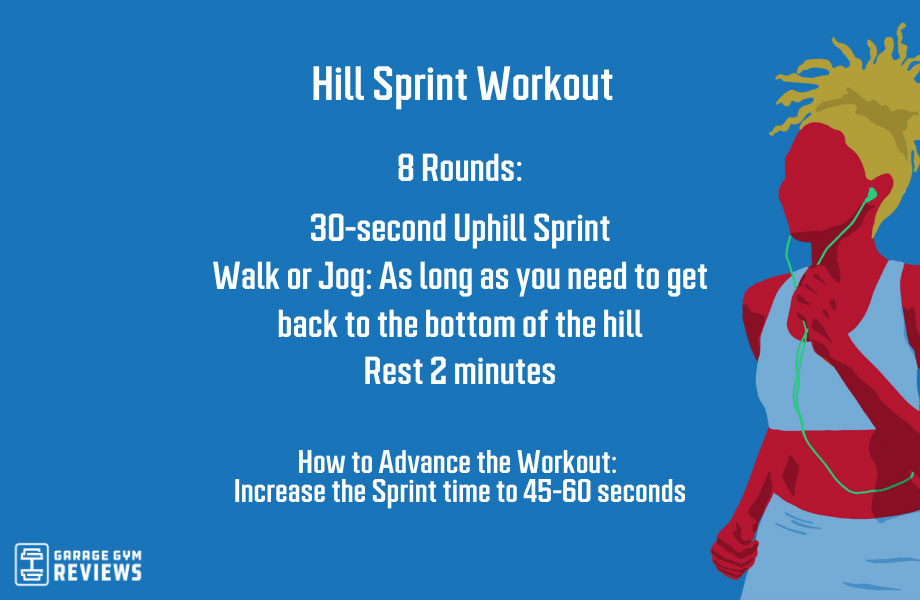
If you don’t have a hill near your home, no problem. You can do a similar workout on a treadmill (yes, the dreadmill!). During your sprint session, adjust the treadmill to a 6 to 10% incline level, then put in your max effort. After 30 seconds, lower the incline level and walk or jog for a couple of minutes before you do your short sprint again.
RELATED: Best Incline Treadmill
“To advance this cardio workout, experiment with different hills,” Kate explains. “Find a steeper one if the current one isn’t challenging enough or a flatter one if you’re finding it tough.” Alternatively, increase the uphill sprint intervals so you’re doing 45 or even 60-second sprints instead of 30. And, if you’re currently walking downhill to recover, switch it up to a light jog.
Endurance Sprint Workout
If you want to use sprint training to help build your stamina for running, pay close attention. “For endurance, we generally see a longer workout time before you rest,” explains Kate. “The whole point of endurance training is that you’re about to maintain a higher work rate for longer.”
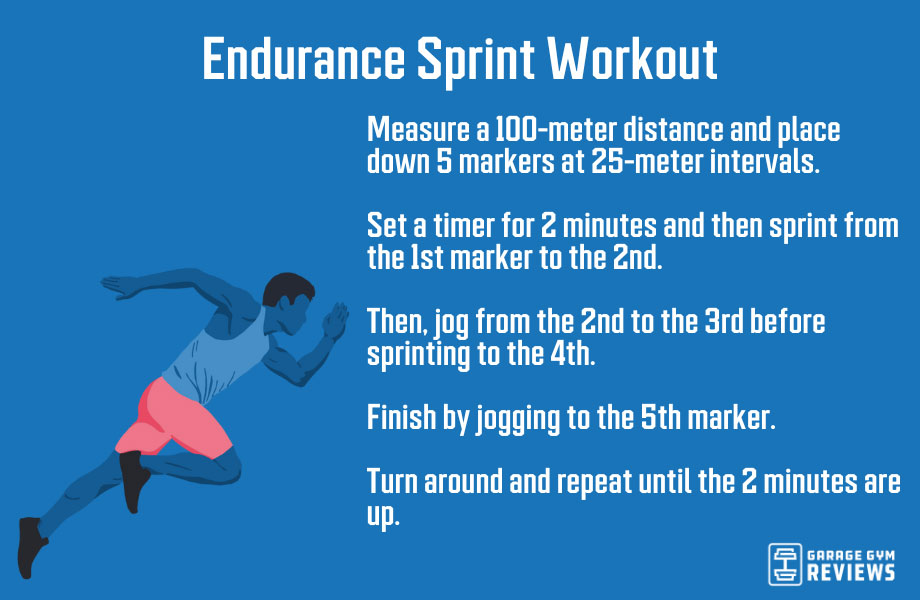
To perform this Endurance Sprint Workout, first measure a 100-meter distance and place down five markers at 25-meter intervals. You’ll want a flat surface, such as a running track. Set a timer for two minutes and then sprint from the first marker to the second. Then, jog from the second to the third before sprinting to the fourth. Finish by jogging to the fifth marker. Turn around and repeat until the two minutes are up.
Rest for two to three minutes. Start again once you’re ready, and repeat the whole circuit five times. To progress, you could increase the duration so the timer goes off after two and a half or three minutes instead of two. Or, you could do the whole thing six to eight times instead of five.
Power Sprint Workout
Sprint workouts for power; now you’re speaking my language. Although cardio is a derogatory term amongst some in the weightlifting world, sprints can help your compound lifts. This is because of the improved VO2 max, which helps with stamina and endurance, getting you through the last few sets of every workout.
RELATED: Conditioning Workouts
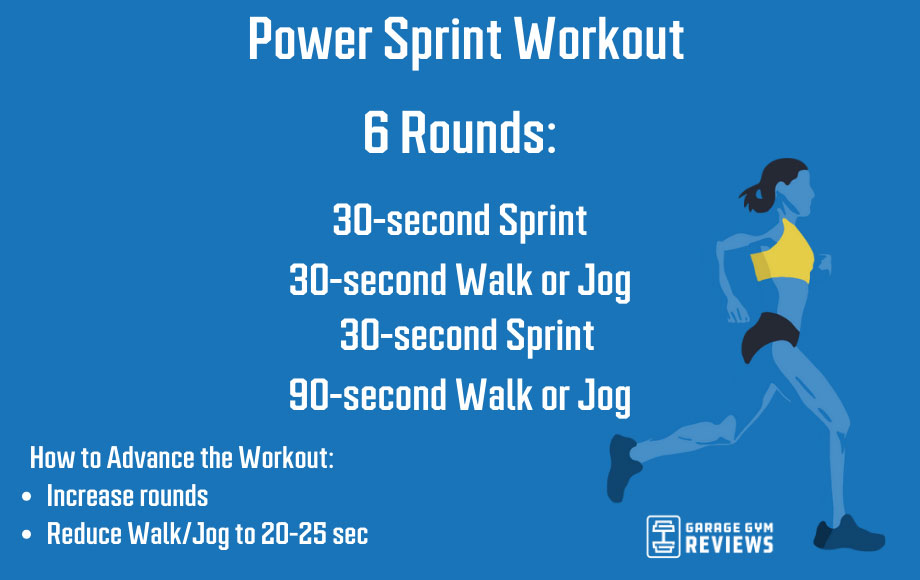
You do two intense sprints with a short rest in between, followed by a longer, steady-state walk or jog to recover. Add more rounds to progress it, or even reduce the short rest period between the two sprints to 20 or 25 seconds. I wouldn’t reduce the 90-second recovery time because you’ll need it to go again the next round.
A quick tip: don’t do this sprint workout the day before leg day because it’s likely that your legs won’t recover in time. Give yourself at least 48 hours.
Distance Runner Sprint Workout
Is your ultimate goal to run a half or full marathon? Or do you already have some experience running these distances and want to improve your pace without hitting a wall? Here’s our distance runner sprint workout:
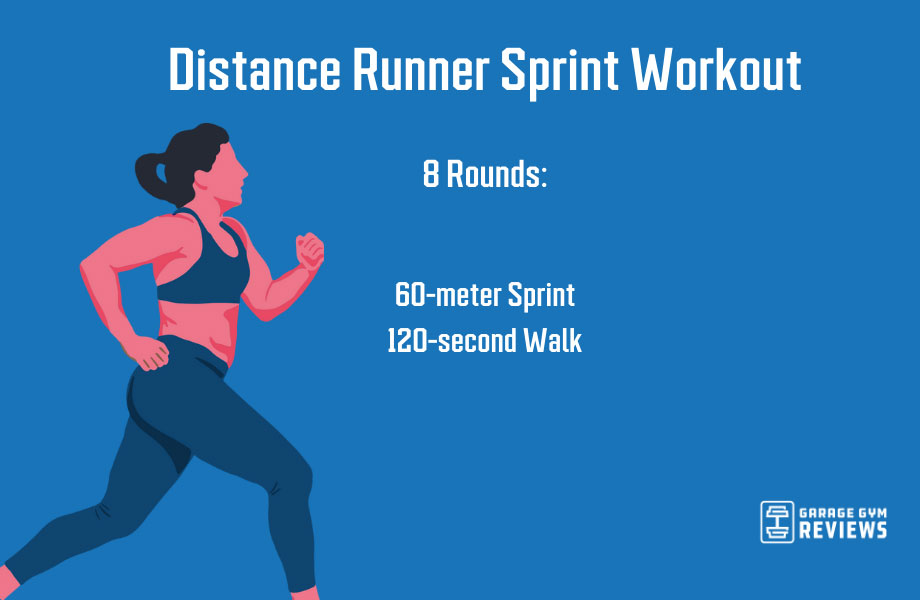
“Running quicker over shorter distances helps to improve your times when it comes to longer distances” says Kate. This workout targets your anaerobic ability because you’re putting in maximum effort for 60 meters before having a longer rest. It’s different to some of the above sprint workouts because the sprint time is shorter, increasing the effort you’re able to give. We encourage you to walk instead of jog during the rest period.
RELATED: Cross-Training for Marathon
To progress it? You could do a couple more rounds or a slightly longer sprint. But honestly, there’s no need. Rest and recover because if you’re training for a long run, it’s likely that your schedule will be packed with runs of various lengths over the coming weeks.
Sprint Workouts: Final Thoughts
There are tons of benefits of sprint workouts, regardless of whether you’re a short, medium, or long-distance runner. These include increased speed, improved VO2 max, and the promotion of fat burning.
- Hydrate throughout. Sprinting can be intense, especially on a hot day. If you want to make the most out of your sprint workout, drink plenty of water before, during, and after exercising. You may even want to take running gels.
- Running shoes. Sprinters need a good pair of running shoes. The best treadmill running shoes differ from the best trail running shoes, so depending on where you’ll be doing the majority of your sprinting, choose accordingly.
- Cool down. A warm-up is important, and so is a cool down. It’s not a good idea to finish a sprint workout and stop and sit down because the lactic acid will build up. Decrease your pace to a light jog or walk for a few minutes, then do some gentle stretches.
Sprint Workouts: FAQs
How long should a sprinting workout be?
A sprinting workout usually lasts between 10 and 30 minutes. Because sprint drills are intense, they take a lot out of you, so going for longer than this doesn’t make sense. Your fitness level needs to be taken into consideration, and some may find they can only do the lower end of this range. There’s no right or wrong answer; it depends on the individual and their goals.
How do you train for sprints?
Training for sprints involves a lot of factors. You’ll need to choose the best sprint workout for you. This will depend on your fitness level, where you’ll be sprinting, the equipment you have, your time constraints, and more.
But that’s not all. I’d suggest doing some strength training and bodyweight training so you build muscle mass to help with your workouts. You’ll also want to ensure that you are sleeping well, taking enough rest days, and of course, getting enough protein. Last but not least, before you do your sprints, warm up to help prevent injury.
What is a 10-1-9 sprint plan?
A 10-1-9 sprint plan is when you perform 10 rounds of one-minute sprints at 9 RPE (rate of perceived exertion). After this intense burst, you’ll recover for a minute at around 3 or 4 RPE before going again for a minute at 9 RPE. Keep alternating until you’ve finished 10 rounds. Be sure to warm up before you start the 10-1-9 sprint plan and cool down afterward.
How can I train my sprint at home?
If you’re limited on space, consider purchasing a treadmill to train your sprints at home. You’ll be able to do regular or incline sprints from the comfort of your home. You can also do long-distance running with it if that’s your thing.
If you have more space and getting a treadmill isn’t an option, measure out a 10 or 15-meter distance and place markers at either end. Set a timer for a minute, and in minute one, do one sprint. Rest, then do two sprints in minute two. In minute three, do three sprints. Keep going with this interval training until you can’t go any longer.
RELATED: Best Treadmills for a Home Gym
References
- Sloth M, Sloth D, Overgaard K, Dalgas U. Effects of sprint interval training on VO2max and aerobic exercise performance: A systematic review and meta-analysis. Scand J Med Sci Sports. 2013 Dec;23(6):e341-52. doi: 10.1111/sms.12092. Epub 2013 Jul 25. PMID: 23889316.
- Plotkin DL, Roberts MD, Haun CT, Schoenfeld BJ. Muscle Fiber Type Transitions with Exercise Training: Shifting Perspectives. Sports (Basel). 2021 Sep 10;9(9):127. doi: 10.3390/sports9090127. PMID: 34564332; PMCID: PMC8473039.
- Bang-Kittilsen G, Engh JA, Holst R, Holmen TL, Bigseth TT, Andersen E, Mordal J, Egeland J. High-intensity interval training may reduce depressive symptoms in individuals with schizophrenia, putatively through improved VO2max: A randomized controlled trial. Front Psychiatry. 2022 Aug 4;13:921689. doi: 10.3389/fpsyt.2022.921689. PMID: 36003983; PMCID: PMC9394183.
- Hazell TJ, Hamilton CD, Olver TD, Lemon PW. Running sprint interval training induces fat loss in women. Appl Physiol Nutr Metab. 2014 Aug;39(8):944-50. doi: 10.1139/apnm-2013-0503. Epub 2014 Mar 18. PMID: 24905559.
- van den Tillaar R, Vatten T, von Heimburg E. Effects of Short or Long Warm-up on Intermediate Running Performance. J Strength Cond Res. 2017 Jan;31(1):37-44. doi: 10.1519/JSC.0000000000001489. PMID: 27191697.
Further reading

Does pre-workout break a fast? Many fitness enthusiasts practice fasting regularly, but how can you ensure your supplements won't sabotage your efforts? Read more

Yet another greens powder added to the harvest? In this Garden of Life Greens review, GGR's nutrition experts explore if it's a bad seed or green of the crop. Read more

Looking for an inexpensive solution for ice baths? Then check out this DIY budget-friendly cold plunge with our Tuff Stuff Stock Tank review. Read more

We pulled together all the best Labor Day sales on fitness equipment as well as tips for finding deals. Save money on barbells, dumbbells, treadmills, ellipticals, supplements, and more. Read more

